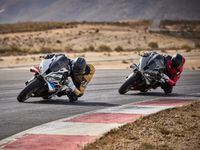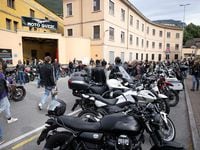Despite the wet weather, the second round of the 2022 MotoGP season proceeded in normal fashion. Because conditions were extremely hot, Michelin had combined a stiffer (cooler-running) carcass construction, last used in 2018, with the tread rubber compounds used in the mid-February test here.
Most riders had mild reactions to these hybrid tires, but for Honda they were a disaster. Pol Espargaró, who had topped the February test, spoke directly:
“Honda designed a new bike that fits perfectly with the current tires. Then there was some problem during the test [tread blistering], and to handle [this] Michelin brought four-year-old tire technology.
“So what we face is we have a bike—the best bike on the grid I would say with the correct tires—but now it’s fitted with four-year-old tires that this bike isn’t made for.
“The rear is not working enough, it’s not making the bike turn. So we are asking so much of the front tire [in compensation], we are generating a huge temperature—we destroy the front tire.
“And you have seen the results of today [Saturday]. All the Hondas out of Q2 and two crashes for Marc on the front.”
Near the end of Sunday morning warmup, as Marc Márquez entered right-hand turn 7, the rear tire swung lazily out, gripped hard, and threw him and his bike high in the air in a violent whirling highside. He had already crashed three times in practice, pushing to the limit in a frankly desperate effort to achieve a forward starting position for the race.
He lay still, stirred, then stood up. Suffering a concussion, he was declared unfit to ride.
Then it rained—with lightning strikes. There were delays, but finally a wet race was declared and started, shortened from the original to 27 laps to 20.
What happened next reminded me of a tongue-in-cheek proposal made by a paddock insider some years ago: “If you want to see really fabulous racing, at each race we should move every rider to a different make of machine.” In other words, completely tear up everyone’s preparations and let them show us how fast they can adapt to having all the variables changed.
At Mandalika, they did very well. Fabio Quartararo won the start from pole as Miguel Oliveira leapt into second from seventh on the grid, and Jack Miller moved up into third from sixth. While Miller is respected as a rain rider, the others were learning as they rode.
Oliveira said, “…in the wet it’s so hard to judge where the limit is. So I followed Jack a couple of laps and then I understood I could go a bit faster.”
Franco Morbidelli (Yamaha) said, “It was a crazy race! The visibility was zero. You could only see red dots in a white cloud.” (MotoGP bikes use taillights in special conditions.)
Thus educated, Oliveira moved past Miller and Quartararo to lead on lap six and applied himself to opening a gap. Quartararo found himself fifth.
Quartararo: “It took me time to realize that I could go that fast in the wet.
“I didn’t expect to get my elbow down in the wet. I understood a lot of things that I hope to put to good use on other tracks as well.”
Just as Oliveira had found he could go faster, now Quartararo advanced as a result of his own high-speed research. With five laps remaining, he dueled with Johann Zarco and was soon second. That was the top-five final order: Oliveira, Quartararo, Zarco, Miller, Rins—KTM, Yamaha, Ducati, Ducati, Suzuki.
Zarco said, “I thought I could go really fast and maybe catch Miguel or save second place before [Quartararo] overtook me. But I was losing a bit too much on the drive and was spinning on corner exit.
“…I saw that I was totally losing the podium. I have to push even more, and I got Jack. I think he was struggling with rear grip on the right side.”
Oliveira rightly credited his strong start with his success: “Without this good start the race could have been a bit different for me. I really couldn’t see anything behind the riders.
“If the race had seven laps more I don’t know, because Fabio was coming pretty strong.” At the end, his margin of victory was 2.2 seconds; of his KTM he said, “The bike is no different from the 2021 version.”
As we saw at the first race in Qatar, riders on already optimized motorcycles (as opposed to new designs such as Ducati’s 2022 and the Hondas) will have an advantage until setup matures for the others.
Álex Rins (Suzuki) said, “…after some big moments on the front end I tried to calm down and be smoother. When Zarco and Quartararo passed me I saw that they had better pace than me and I realized I couldn’t do more without big risk. So I took fifth place.”
For the 2023 season, pressure is building to ban the new variable ride height systems currently in play. Such systems originated from the “holeshot devices” used to improve motocross starts. Those extremely tall MX bikes wheelie easily, losing acceleration. To lessen the effect, a mechanical latch holds the front suspension compressed just for the start. This lowers the bike/rider center of mass, lessening the tendency to wheelie and raising the level of acceleration possible. The first time the rider brakes, the latch releases, and the suspension functions normally for the rest of the race.
In MotoGP, Ducati and others have gone further, creating systems that can lower the bike repeatedly, not just at the start, thus enhancing acceleration and braking. In effect, when activated the suspension is partially compressed for accel/decel, turning the bike into a dragster/brakester; the rest of the time, the suspension is unrestricted, providing normal cornering clearance. As the rule book bars the use of externally powered systems, power is evidently bled from the normal pumping action of the suspension and stored for subsequent use. Ducati has aggressively led this development, but the systems of the other constructors have shown promise too.
Teams in the other camp have cited cost and safety issues, and have objected that such systems have no application on production motorcycles. Gianluigi Dall’Igna, Ducati’s racing general manager, said, “I’m happy with what we have developed and I think we can do even better in the future.”
In other words: Sure, go ahead and ban it. We have lots more surprises for you. It’s hardly the first time that Ducati has found itself at odds with the Japanese consensus.
Will paddock lawyers now object to other MotoGP technologies not presently found in the showroom, features such as carbon brakes and pneumatic valve springs? That class of racing already exists—World Superbike.
As at Qatar, a pattern has failed to emerge from the results. In its place are surprises. The fearful squad of eight Ducatis has failed to dominate. The Yamahas have emerged from their perennial doldrums to show strong performance. The hot young riders favored by pundits have yet to crush all opposition. Perhaps normality will indeed return.
More and more riders are crowding into that single second behind the quickest lap time (21 at the Mandalika test). This confirms Dorna’s success in developing systems to provide competitive equipment and a steady supply of strong riders graduating from Moto2.
It also creates a situation in which a small setup discovery can transmute any one of these men into a winner on a given day. What if this season continues as it has begun?
















/cloudfront-us-east-1.images.arcpublishing.com/octane/YMWAIPIPSJAOXOU3QMJMGH37OM.jpg)


/cloudfront-us-east-1.images.arcpublishing.com/octane/EJ6KZRGAYBCVXNL2PJXL37UVWQ.jpg)
/cloudfront-us-east-1.images.arcpublishing.com/octane/AAN4TI76M5H5JMUVEIGASWXBDU.jpg)
/cloudfront-us-east-1.images.arcpublishing.com/octane/P3RXD2UCPFF37CMB7CHPVKXORY.jpg)
/cloudfront-us-east-1.images.arcpublishing.com/octane/VZEG2EJI2RDFZNHLRZMU56MD3Q.jpg)
/cloudfront-us-east-1.images.arcpublishing.com/octane/GVJQO5FFOFBWNGODOBRB4FBAW4.jpg)
/cloudfront-us-east-1.images.arcpublishing.com/octane/BIVAK2SFIBDJJM25E7I5VU2FJE.jpg)
/cloudfront-us-east-1.images.arcpublishing.com/octane/CH5VX52UG5CFHOVH5A6UYEFWWA.jpg)
/cloudfront-us-east-1.images.arcpublishing.com/octane/ZVGJNGZRU5C33N7KN23BBFKSC4.jpg)


/cloudfront-us-east-1.images.arcpublishing.com/octane/CZ5OM3E43ZEXJHY7LCYXCHLIKI.jpg)
/cloudfront-us-east-1.images.arcpublishing.com/octane/DF5T4K5KPZFJXFCTGPYR77PKJM.jpg)
/cloudfront-us-east-1.images.arcpublishing.com/octane/RMCT2KVQBJHBZMRTSLOVPMOILU.jpg)

/cloudfront-us-east-1.images.arcpublishing.com/octane/K45KB2XHQVA65DX7VN4ZSMT2BI.jpg)
/cloudfront-us-east-1.images.arcpublishing.com/octane/FNHXQQ56BRD7TO4YIJ453PNG2M.jpg)
/cloudfront-us-east-1.images.arcpublishing.com/octane/OIKJC4JA3ZH7BMKUGWYKBIY5FA.jpg)
/cloudfront-us-east-1.images.arcpublishing.com/octane/MT2SAEWY6FDXFBYSLDE3AEFDTM.jpg)
/cloudfront-us-east-1.images.arcpublishing.com/octane/66UPKPYVURBPRCP5HXSN56MEMM.jpg)
/cloudfront-us-east-1.images.arcpublishing.com/octane/EOREGDSRKFDCRJC6K3EDVHBGCE.jpg)
/cloudfront-us-east-1.images.arcpublishing.com/octane/42RF63Q3LVCMBP3DGTWXFYSMOA.jpg)